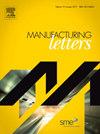Iterative correction of robotic grinding using spatial feedback for precision applications
IF 1.9
Q3 ENGINEERING, MANUFACTURING
引用次数: 0
Abstract
Since the advent of robots, many tasks that were originally performed by humans have now been tasked to industrial robots. From a manufacturing standpoint, robots have primarily been used in pick-and-place or other non-machining operations that require high repeatability. However, with the increasing availability of CAD/CAM software and the development of high-precision metrology, comes the opportunity to integrate robots into a wider variety of manufacturing processes through the use of feedback control. One such machining operation that is being explored is precision grinding of metal parts. Most other work in this area has focused on force regulation to improve grind quality; however, this paper takes a different approach. In this work, an Iterative Learning Control (ILC) algorithm is implemented to correct the geometric error directly by altering the toolpath trajectory. Specifically, in this framework, a conservative initial cutting trajectory is implemented using a 6-DoF robotic grinding system, and the resulting part geometry is measured via a high-precision laser scanner. Based on the resultant geometric error, the toolpath is corrected and then rerun on the part. This process is then repeated iteratively until sufficient accuracy is achieved. Due to the inability to replace material in overground regions, the controller is designed with an emphasis on reducing overshoot which cannot be corrected. The controller is experimentally validated by grinding an elliptical pocket which meets FAA specifications for corrosion removal in aircraft. The results showed that within seven iterations the entire error surface could be brought to a tolerance of ±0.150 mm for the given geometry.
利用空间反馈对机器人打磨进行迭代修正,以实现精确应用
自从机器人问世以来,许多原本由人类完成的任务现在都交给了工业机器人。从制造的角度来看,机器人主要用于拾放或其他需要高重复性的非加工操作。然而,随着 CAD/CAM 软件的日益普及和高精度计量学的发展,机器人有机会通过使用反馈控制,集成到更广泛的制造流程中。目前正在探索的一种加工操作是金属零件的精密打磨。该领域的大多数其他工作都侧重于力的调节,以提高打磨质量;但本文采用了不同的方法。本文采用迭代学习控制 (ILC) 算法,通过改变刀具轨迹直接修正几何误差。具体来说,在此框架下,使用 6-DoF 机器人磨削系统实现保守的初始切削轨迹,并通过高精度激光扫描仪测量由此产生的零件几何形状。根据由此产生的几何误差,对刀具轨迹进行修正,然后在零件上重新运行。这一过程反复进行,直到达到足够的精度。由于无法替换过磨区域的材料,控制器的设计重点是减少无法修正的过冲。该控制器通过磨削符合美国联邦航空局飞机除锈规范的椭圆形凹槽进行了实验验证。结果表明,对于给定的几何形状,在七次迭代中,整个误差面的公差可达到 ±0.150 毫米。
本文章由计算机程序翻译,如有差异,请以英文原文为准。
求助全文
约1分钟内获得全文
求助全文
来源期刊

Manufacturing Letters
Engineering-Industrial and Manufacturing Engineering
CiteScore
4.20
自引率
5.10%
发文量
192
审稿时长
60 days
 求助内容:
求助内容: 应助结果提醒方式:
应助结果提醒方式:


